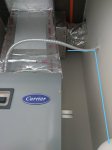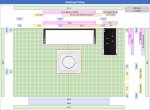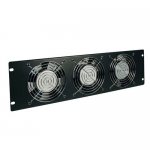- Thanks for weighing in here. Man that stinks your solution didn't work.
- I think you are right about that amount of gear needing real infra, A/C, and a dedicated circuit. Perhaps that fan didn't work because it didn't create the pressure differential needed and is a "whiffer" as @Redcoat calls them?
I'm curious:
- Do you have a before / after temp measurement for the any of those servers? Did the fans have any impact?
- Where were you exhausting to?
- What kind of intake fan were you using?
Yeah... oh well, cost of doing business. That closet has two 115/30 circuits in it (one's spare, one's feeding the UPS).
I didn't do any significant temp measurements. The big problem with insufficient cooling in such a small space is it dramatically enhances the progress of thermal runaway. If I go close the door and seal the room right now, ambient air temperature will increase 20 degrees in about 60-90 seconds. Here's some good rough number calculations, with the knowledge that these assume standard temperature and pressure, become increasingly inaccurate as the temperatures rise, and assume a perfectly sealed environment (no accounting for radiant heat loss through the walls):
10A * 115V = 1150W = 3,924BTU/hr.
0.24BTU will raise 1lb. air 1 degree F.
0.075lb./cuft air. So 96cuft = 7.2lb.
So, 1.728BTU will raise our ambient temperature 1F.
With the above, we know we're generating 65.4BTU/min. That equates to 37.8F/min. At this rate, even with HVAC, a 1-2min power outage can be a Big Problem. Even if you half that number, at an ambient 72F, in 5 minutes, you're at 166.5F. Keep in mind that wood autoignites between 160-270F depending on species, and sheetrock 450-475F. You've got a fire on your hands pretty quickly.
You can also calculate air flow as: BTU = dT * CFM * 1.08 (the constant assumes 70F at sea level, close enough). If you're willing to accept a 20 degree rise, you need 188CFM. But that assumes perfect airflow, which I think was my problem.
I took an old door, cut a 10x6 vent through it, filled the rest of the door with expanding foam, then mounted a 20" box fan to the inside. The fan was sealed to the door so there was no air reingestion from the hot side. They say 2500CFM, but I don't buy that. That's at zero static pressure. But I would've expected more than 200CFM input.
The exhaust was a Panasonic 150CFM WhisperQuiet fan, ceiling mounted, with exhaust outside via a 6" flexible duct with no kinks. It should have been able to deliver 150CFM through the ductwork.
Yes, this meant that conditioned air was being exhausted to atmosphere. Not the ideal scenario, but worthy of a test. And, as long as the hot air being expelled was warmer than the make-up air from the outside world, it should result in a net savings (but this assumes the ventilation is carefully balanced... if too much ventilation existed and there was minimal temperature rise, which would be best, then energy would be lost).
With all of this in place, I watched temperatures climb from ~72F to ~90F in about 20 minutes before I aborted the test. 90F was too hot for everything and the temperature wasn't showing signs of stabilizing, so I may have still been underventilated and looking at the possibility of thermal runaway.
Now, what I expect was happening (but never proved through the use of colored smoke/etc.) was that air was flowing from the inlet directly to the exhaust, largely bypassing the pocket of hot air being created behind the servers. I was hoping the box fan would introduce air with enough velocity to push this air out, but apparently not. The path of least resistance would be straight out the exhaust.
My potential solution to this (negating the issue of the loss of conditioned air to atmosphere) would be to seal the system in some sort of cabinet. Ensure that the ONLY air in is from the conditioned supply (through the front) and the ONLY air out is through the exhaust vent (through the rear). Assuming you can balance the intake and exhaust fans (variable speed fans would be best here) there should be no static pressure issues to deal with (intake should "push" with the same pressure the exhaust "pulls").
But, with all that said, I'm just going to drop a 1-ton low-ambient ductless mini-split AC in and call it a day. Eventually, I'll add a sufficiently large diesel generator to run the whole house.
Hopefully my ramblings will benefit you somewhat :)








